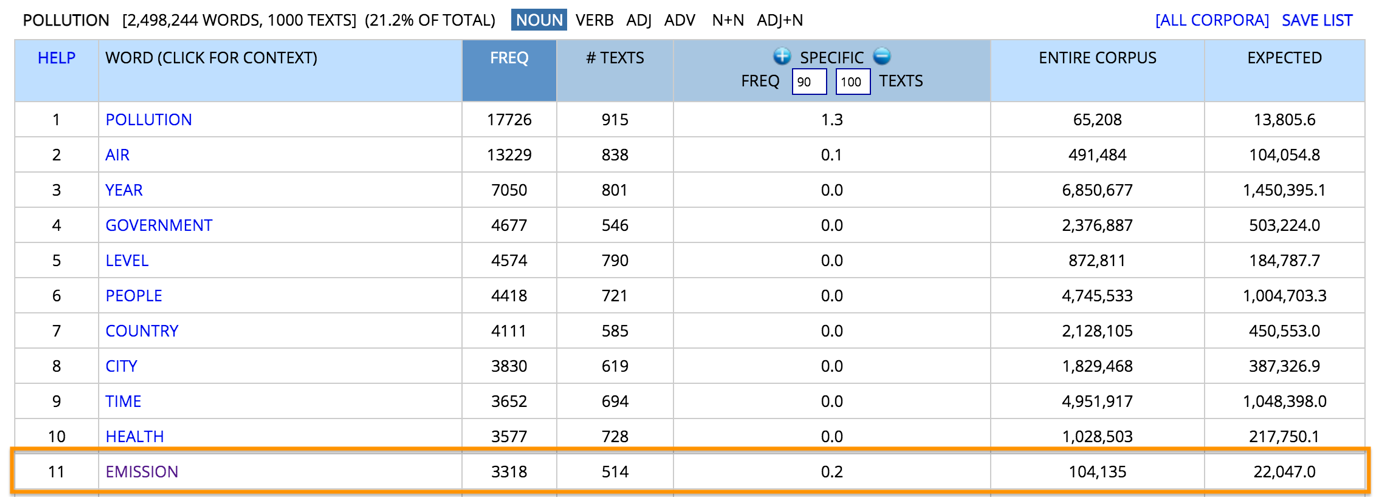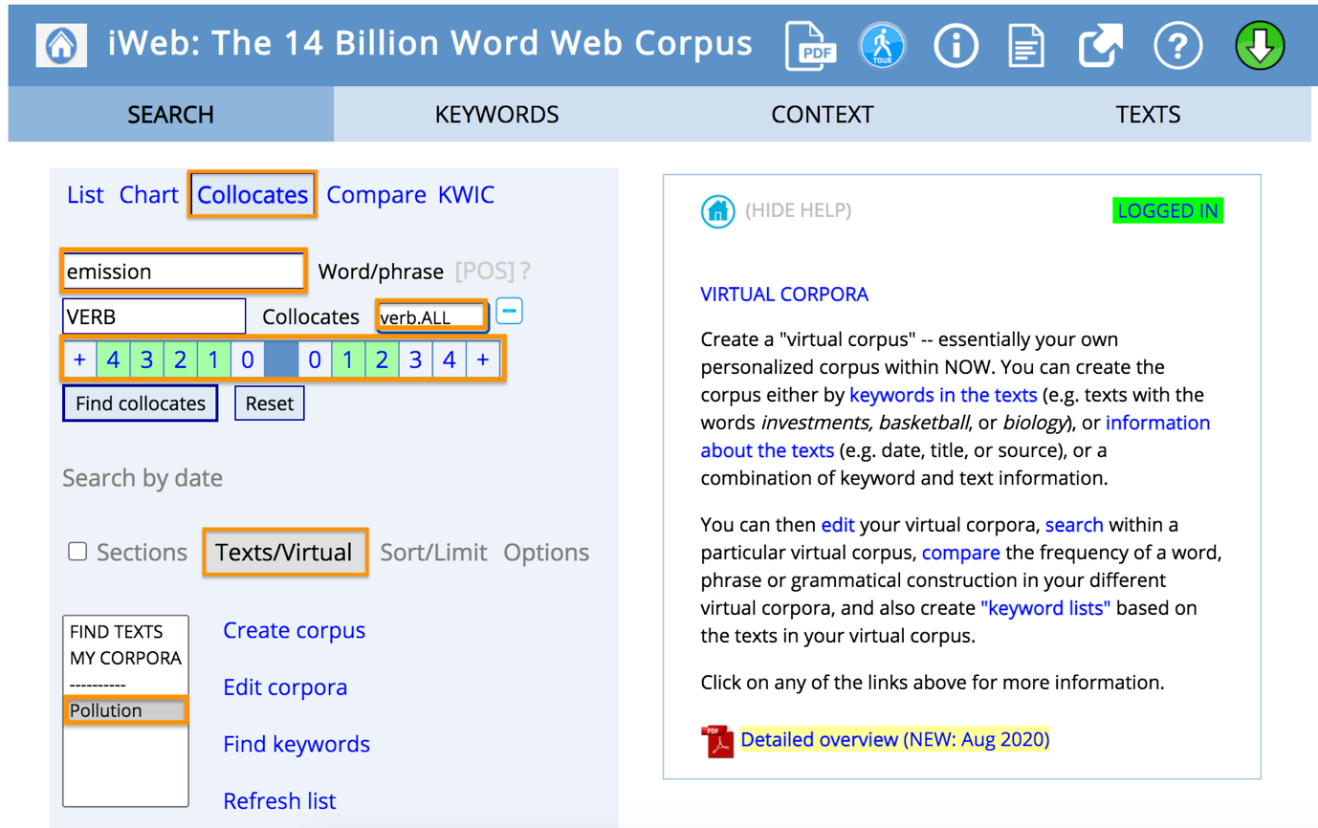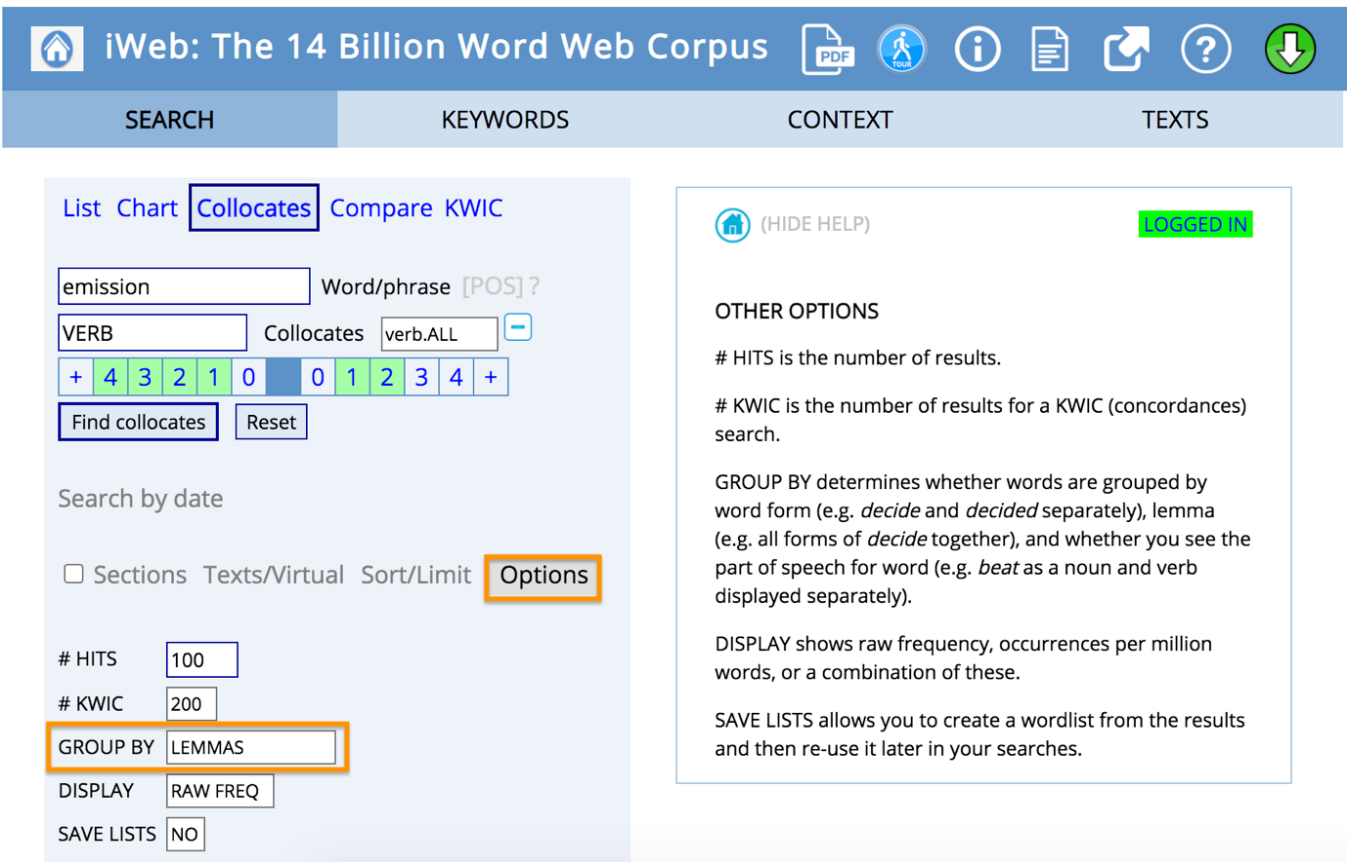Lesson ideas: Content and Language Integrated Learning (CLIL) at secondary school
13 Building a corpus to create materials for a debate on pollution
Marie Gröninger and Ha Mi Nguyen
1 Introduction and rationale
Enabling learners of English to debate current issues that dominate public discourse is a key communicative aim of teaching English. As a major vector of climate change, pollution makes for an ideal debating topic for the English language classroom. However, given that it is a specialised topic, it can be difficult for teachers and learners to access the appropriate vocabulary and idiomatic phrases to do so successfully. The corpus built in this step-by-step guide to conducting corpus linguistics research helps teachers to compile lists of authentic articles and useful idiomatic phrases on the topic of pollution. The chapter will also introduce examples of how to implement the corpus findings in teaching materials. According to the English curriculum of Lower Saxony (Germany), dealing with topics from different school subjects in bilingual teaching is a highly motivating and effective way of acquiring a second language (Niedersächsisches Kultusministerium 2015: 31). Climate change is one of the core topics featured in the geography and chemistry curriculum (Niedersächsisches Kultusministerium 2015: 14) for grades 9 and 10 at Gymnasium (advanced secondary school in Germany), whilst also touching on contents from biology and politics.
Interdisciplinary climate change education “helps people understand and address the impact of global warming, increases ‘climate literacy’[1] among young people, encourages changes in their attitudes and behaviour, and helps them adapt to climate change related trends” (Unesco, n.d.). Pollution is a serious global issue that is addressed in political discussions. Therefore, the topic is very prevalent in students’ daily private lives. Many young people attend the Fridays for Future demonstrations, thus potentially increasing the students’ interest in the topic. Enabling students to communicate central issues of pollution in English is thus a meaningful preparation for encounters outside the classroom.
Outline and objectives
In this lesson, students will be introduced to general vocabulary around the topic of pollution. They will describe pictures, play a vocabulary game, and prepare and hold a debate on the topic of pollution. For the debate, the students will be divided into five groups. Four groups will be assigned a role and the members of the fifth group will moderate the debate. The four groups will read different articles which are related to their role, and work out arguments regarding pollution in order to debate with the opposing group.
Lesson time: ca. 90 min.
Teacher preparation time: ca. 60 min.
School Type: Gymnasium (upper secondary school)
Level: 10th Grade
Learning Objectives:
- Students can discuss ideas, opinions and knowledge about pollution as part of a roleplay.
- Students can formulate their own opinions on the topic.
- Students can make use of debating strategies and useful phrases for debating.
- Students can connect, describe and explain the causes and effects of pollution as a subtopic of climate change.
- Students can use key vocabulary pertaining to the semantic field of pollution.
2 Corpus, tools and methods
The News on the Web (NOW) corpus on english-corpora.org includes a range of broadsheet newspapers such as The Guardian, as well as tabloid press such as the Daily Mail. The corpus thus reflects the language input of the general public because there is a variety of written articles on the topic composed for different audiences. It is a rich source of frequent vocabulary useful for talking about scientific and political issues, as well as idiomatic phrases demonstrating how to use the new vocabulary in context. This kind of authentic language is very important for designing materials for the English as a Foreign Language classroom.
3 Step-by-step guide
Teacher preparation
Corpus compilation
Step 1: Registering on english-corpora.org
To be able to access the NOW corpus, register on english-corpora.org and select the corpus by clicking on “News on the Web (NOW)” in the table.

Step 2: Creating a virtual corpus
The “FIND TEXTS” function allows you to create a virtual corpus based on keywords. To use this function, type in your keyword in the query box; in this case it is pollution. Second, select Texts/Virtual tab and then click on “FIND TEXTS” (see Fig. 2).

Third, select Options and type in your desired number of results in the “#HITS” box. To ensure a greater variety of texts, 1,000 texts could be retrieved. To see the results, select “Find matching strings” once you have adjusted the settings as described above (see Fig. 3).

Next, you will see a list of texts that form your personal virtual corpus. You can click on the “SAVE LIST” option at the top left corner of the list to save your virtual corpus and to access it at any time in the future.
Designing corpus-based teaching materials
Task 1
To find certain keywords in your corpus, you can select e.g.“NOUN” to find specific nouns in your corpus. This option appears in your “virtual corpora” list next to the name of your saved corpus (see Fig. 4). If you click on “NOUN”, a list of nouns and their frequencies in your corpus will appear. If you then click on a word from this list, e.g. emission (see Fig. 5), a list is displayed showing in which context the word emission is used in the newspaper articles of your virtual corpus, alongside the date of the article, the website it was published on, and further information. You can also click on the number in the left column to see the expanded context in which the word is being used (see Fig. 6).



For the warm-up activity, which in this lesson will be the vocabulary game Last Man Standing, the teacher needs to prepare a list of vocabulary for the students to learn before this lesson.
This vocabulary list contains important vocabulary on the topic of pollution. The list will include the English word with three typical collocations and an example sentence in which the word is used.
To create this list, use the “FIND KEYWORDS” function and select as many nouns, verbs, adjectives etc. as needed for the vocabulary list (see Fig. 4).
There is going to be a huge collection of words to select from. It is therefore important to choose them carefully with your students in mind. First of all, you can find the most frequent nouns, verbs, adjectives etc. in your virtual corpus on pollution (see Fig. 4). Of course, not every word is going to be relevant for your students. It is helpful to view the text(s) that the students will read in the second task as a comparison in order to see which of the listed words may be necessary to understand them. Furthermore, Francine Johnston’s article How to Select Words for Vocabulary Instruction provides handy criteria for the selection. Some of the criteria Johnston mentioned are “importance” and “transferability” of words (Johnston, n.d). Teachers should ask themselves what important words their students need to learn in order to understand the selection of texts and to successfully hold a debate on their own.
The next step after having chosen the appropriate vocabulary is to find two to three collocations per word. To start off, e.g. type in emission in your virtual pollution corpus (from 4.1.1) and choose the function “Collocates” (see Fig. 7).

Under Options, is also helpful to select “GROUP BY: LEMMAS” instead of the default “WORDS” (see Fig. 8) because the different inflections of verbs and nouns are then grouped together.

There are several options to look for useful collocations of the word. For example, you can type in an asterisk (*) in the second search box to look for all word classes. Another option is to specifically search for a word class such as verbs in order to find out which verbs are frequently associated with the word in texts about pollution (see Fig. 8). It may be necessary to vary the number of positions before or after the word depending on what word class you are looking for. Verbs, for example, are often several word positions before a noun. You can change the collocational range you are searching for by adjusting the numbers between +4 and 4+. The range queried is highlighted in green (see Fig. 7).
In this case, the verb meet was the most frequent verb collocate of emission within our virtual pollution corpus (see Fig. 9).

However, a brief look at the concordance lines of meet reveals that meet + emission(s) never occurs on its own (see Fig. 10). Instead, the verb meet collocates with emission norms/standards/targets and other semantically related nouns.

When creating your own collocation list, please keep in mind that a certain inflection of a word may be more idiomatic than others. For example, while looking for verb + emission collocations, it becomes clear that the plural of emission, i.e. emissions, is used much more frequently. The same is true for adjective or noun + emission. The singular form of emission, on the other hand, is mostly found in emission + noun constructions, i. e. emission standards. As a tip, an easy way to check this is to search for different inflections in a corpus while using the setting “GROUP BY: WORDS”. The frequency will help you to decide which inflections should be included in the collocations you decide to include in your teaching materials.
In addition, learners are known to find example sentences most useful. Make sure that they are from your corpus to ensure authenticity. An example of what a finished vocabulary list could look like can be found in the appendix.
Task 2: Instructions for one example text
The second task prepares the students for their roles in the debate. To do this, the teacher needs to prepare a variety of texts for each group in advance. The texts should inform the students about pollution and ideally contain useful information and arguments which can then be used in the debate. In the following, two ways of finding appropriate texts are outlined.
Option 1: Searching for a text in your own virtual corpus
For this lesson, this option was chosen to find the ideal articles for the reading task. The virtual corpus includes many great articles that suit the purpose of this lesson. To find a text in your individual corpus, select your virtual corpus. In this case, it is the pollution corpus that was created in 4.1.1. (see Fig. 11). Within this corpus, you have a variety of texts that you can choose from. Next, you can click through the websites to find the perfect text(s) for the lesson (see Fig. 12).


Option 2: Searching for a text in the NOW corpus
This second option enables you to search through the entire NOW corpus by simply typing in a keyword. In this example, the term air pollution is used. In addition, it is possible to specify the dates of publication for the texts in your search (see Fig. 13). The more recent the texts are, the more likely it is that the full text will still available on the publisher’s website.

Next, you will see a list of websites that have published articles featuring the word or topic that you searched for. Once you have found an interesting website, you can click on the number on the left column to obtain further information about the context in which your query word is used. In this case, no. 58 was chosen, which is an article from The Guardian (see Fig. 14).


You can now click on the number in the left column to see the expanded context in which the word is being used (see Fig. 15).
You will also find a link to the article (see Fig. 16).

Four example texts we suggest could be used for this task are linked in the appendix, though your own selection of texts will, of course, depend on your students’ proficiency levels, needs and interests.
Task 3
The final task of the session is the debate. For this task, it is necessary to prepare a list of useful phrases for engaging in a debate. Teachers should provide their students with the list so that they can study it in advance. It will guide the learners through the debate and support them if needed. You may adjust your list to your students’ needs by, for example, removing the translation into students’ first language and leaving an empty column instead. This leaves space for your students to fill in their own translation, or other notes that they may find useful.
At this point, the students are already prepared and have acquired information and arguments for their specific roles.
Lesson plan
|
Phase |
Task |
Implementation |
Interaction Form |
Material/Medium |
|
Introduction 10 min |
Picture impulse on the topic pollution |
Description of and comments on the picture |
Plenum |
Smart board, Picture (see appendix) |
|
Task 1 5 min |
Vocabulary game: Last Man Standing |
Teacher names the theme pollution, students name vocabulary |
Plenum (standing) |
Ball |
|
Task 2.1 30 min |
Preparing roles for debate |
All groups read through their texts and develop arguments with theinformation provided |
Group work |
Worksheets, extra sheet for notes |
|
Task 2.2 10 min |
Exchanging arguments regarding the motion |
Collaboration with the other pro/con role |
Group work |
Notes, arguments from 2.1 |
|
Task 3 20 min |
Debate in small groups Motion: Preventing Pollution is not a Matter of Money |
Students discuss in debate groups (one student per role) under the guidance of a moderator |
Jigsaw group work |
Notes, arguments from 2.1 |
|
Conclusion 10 min |
Reflection on debates |
Students comment on the strategies of the debaters and state their own opinions on the topic. |
Plenum |
|
|
Application/ Homework 5 min |
Analysing a cartoon |
Finish analysis as written homework. |
Plenum |
Cartoon (see appendix) |
Instructions for tasks
Task 1: Vocabulary Game – Last Man Standing (warm-up activity)
The teacher names the topic, pollution, for which the students have already learnt the vocabulary for homework ahead of the lesson. At the beginning, all of the students have to stand up and the teacher throws a ball to a student who has to come up with a word that fits that topic. That student throws the ball to the next student who again has to come up with another word. Students who catch the ball and cannot come up with a word have to sit down. This game continues until there is only one student left standing. The last standing student is the winner of the game.
Task 2.1: Reading
The teacher presents the motion of the debate “Preventing Pollution Is Not a Matter of Money”. In the first stage of the Jigsaw method, the students are divided into five expert groups. Each group will be assigned one of the roles.
First of all, informative texts are handed out to the first four groups with potential arguments supporting the position they will have to defend. These texts include reading tasks to help them filter and develop arguments for the debate. Moreover, they will have to think about strategies to communicate these arguments in the debate. The fifth group is the group of moderators. It is best suited for high ability students. These students have access to all four texts in order to prepare for their role. They will be in charge of opening the debate, facilitating transitions between arguments, encouraging everyone to participate actively and asking questions whenever needed.
Roles in the debate: “Preventing Pollution Is Not a Matter of Money”
PRO GROUP
- Representative of an environmental organization
- Student who supports Fridays for Future
CON GROUP
- CEO of a successful car manufacturer
- Parent of four who cannot afford an environmentally-friendly lifestyle
MODERATOR GROUP
Task 2.2: Exchanging arguments
Students who have been assigned the same role form groups and review their arguments. This step encourages the students to think about possible ways to support each other’s arguments, thus strengthening their side of the motion. The students should also think about possible arguments from the opposing side and come up with potential rebuttals.
Task 3: Debate
For the debate, new discussion groups are formed; those discussion groups include at least one representative of each expert group. This means that each discussion group has a representative of each role plus a moderator who is going to be in charge of structuring as well as keeping the debate going. The purpose of this format is to encourage every student to participate actively.
4 Options and further ideas
Option:
The teacher could create a pro and con group for low ability learners who may obtain texts that are easier to understand and/or include additional information such as graphs, images or an additional vocabulary list.
Further idea:
Fish Bowl debate for the follow-up lesson:
Fishbowl is a strategy for organizing medium- to large-group discussions. Students are separated into an inner and outer circle. In the inner circle, or fishbowl, students have a discussion; students in the outer circle listen to the discussion and take notes (tolerance.org, n.d.).
A Fish Bowl debate gives students the opportunity to present their findings in front of the whole class while the observers note down the structure of the debate, as well as the vocabulary employed. That way, the teacher is able to retrace how well the Jigsaw classroom worked out and the students can use their results in a bigger context while revising the acquired vocabulary and debating strategiesonce more.
5 Caveats and limitations
In order to create such a lesson, it is important to become familiar with english-corpora.org and not lose your patience at the first mishap! Error messages, resulting e.g. from forgetting to put a space or ticking the wrong box, are certainly frustrating. Nonetheless, the results obtained from working with a corpus are very reliable and enable you to find vocabulary that goes over and beyond what textbooks include, thus expanding the vocabulary taught in a more authentic way. Textbooks and other lists might include vocabulary around specific topics such as pollution, but the corpus allows you to look for frequent idiomatic phrases and collocations and to explore the wider context in which they are used.
Another difficulty might occur for non-paying users of english-corpora.org, who regularly receive a notification to upgrade their account. This can be ignored. After a few seconds of waiting, the search can be continued. Additionally, when creating the virtual corpus, it is important to choose a keyword that is often used in the desired context. It is worth comparing results from different keywords because the use of a good keyword is crucial to create a reliable virtual corpus. Depending on the learning group, the complexity of the tasks and the debate can vary. At first, students may be overwhelmed by the debating task, or else they might find it highly motivating and will be very spontaneous in their contributions. It is important to consider the specific learning group, that the necessary vocabulary has been introduced beforehand, and that the students are familiar with the concept of such a debate.
6 Conclusion
Even though preparing the vocabulary list may take some time, in our opinion, the result is very rewarding because you end up with a list of frequent, authentic examples that can always be reused or extended in future lessons. Moreover, this method can be applied to a whole range of other topics. Once the teacher has worked with this method once, they will always be able to go back and repeat the steps, applyingthe methodto a different topic. Teacher preparation time will considerably decrease once they have gotten used to the method.
7 Resources
News On The Web Corpus (NOW). https://www.english-corpora.org/now/.
8 References
Climate.gov. 2009. What is Climate Literacy? https://www.climate.gov/teaching/essential-principles-climate-literacy/what-climate-science-literacy (09 January, 2021).
Englisch Hilfen. n.d. Diskussionen auf Englisch – Wichtige Wendungen. https://www.englisch-hilfen.de/words/diskussionen.htm (31 July, 2020).
Johnston, Francine. n.d. How to Select Words for Vocabulary Instruction. https://assets.pearsonschool.com/asset_mgr/current/201640/Francine_ArticleForResearch.pdf (31 July, 2020).
Lehrerfortbildung-bw.de. n.d. Material 12: Debate vocabulary. https://lehrerfortbildung-bw.de/u_sprachlit/englisch/gym/bp2004/fb1/binnendiff/2_ue_mat/mat14/ (04 August, 2020).
Niedersächsisches Kultusministerium. 2019. Kerncurriculum für das Gymnasium, Schuljahrgänge 5-10: Chemie. https://cuvo.nibis.de/cuvo.php?skey_lev0_0=Schulbereich&svalue_lev0_0=Sek+I&skey_lev0_1=Fach&svalue_lev0_1=Chemie&skey_lev0_2=Dokumentenart&svalue_lev0_2=Kerncurriculum&docid=1061&p=detail_view (15 July, 2020).
Niedersächsisches Kultusministerium. 2015. Kerncurriculum für das Gymnasium, Schuljahrgänge 5-10: Erdkunde. https://cuvo.nibis.de/cuvo.php?skey_lev0_0=Schulbereich&svalue_lev0_0=Sek+I&skey_lev0_1=Fach&svalue_lev0_1=Erdkunde&skey_lev0_2=Dokumentenart&svalue_lev0_2=Kerncurriculum&docid=1112&p=detail_view (15 July, 2020).
Niedersächsisches Kultusministerium. 2015. Kerncurriculum für das Gymnasium, Schuljahrgänge 5-10: Englisch. https://cuvo.nibis.de/cuvo.php?skey_lev0_0=Schulbereich&svalue_lev0_0=Sek+I&skey_lev0_1=Fach&svalue_lev0_1=Englisch&skey_lev0_2=Dokumentenart&svalue_lev0_2=Kerncurriculum&docid=1197&p=detail_view (15 July, 2020).
Tolerance.org Website. n.d. Teaching Strategy – Fish Bowl. https://www.tolerance.org/classroom-resources/teaching-strategies/community-inquiry/fishbowl#:~:text=Fishbowl%20is%20a%20strategy%20for,the%20discussion%20and%20take%20notes (12 August, 2020).
Unesco Website. n.d. Climate Change Education and Awareness. https://en.unesco.org/themes/addressing-climate-change/climate-change-education-and-awareness#:~:text=Education%20is%20an%20essential%20element,to%20climate%20change%20related%20trends (15 July, 2020)
9 Appendix
Pictures
Picture impulse

Image credits (left to right, top row first):
- “Solar Panels” by RecondOil is licensed under CC BY 2.0
- “Climate change – environment” by RecondOil is licensed under CC BY 2.0
- “MY NEW ENVIRON-MENTALIST FAKE!” by The PIX-JOCKEY (visual fantasist) is licensed under CC BY-NC 2.0
- “Coal power plant” by eutrophication&hypoxia is licensed under CC BY 2.0
- “Global Warming (Effetto Serra)” by The PIX-JOCKEY (visual fantasist) is licensed under CC BY-NC 2.0
- “environment pollution” by RecondOil is licensed under CC BY 2.0
Cartoon for homework
“091207usatoday global warming.91” by RedMonk Red is licensed under CC BY-NC 2.0
Worksheets
Vocabulary list
Here is an example of what a vocabulary list with collocations could look like:
|
English |
German |
Collocations |
Example sentence |
|
carbon dioxide [ˌkɑːbndaɪˈɒksaɪd] n, SYNONYM: CO2 [siː.əʊ.tuː]
|
Kohlenstoffdioxid, CO2 |
|
By 2030 the U.S. will reduce its carbon dioxide emissions by nearly 30% below 2005 levels. |
|
emissions [ɪˈmɪʃəns] n |
Ausstöße |
|
The factory promised to reduce the emissions of greenhouse gases. |
|
emission targets/norms/standards etc. [ɪˈmɪʃənˈtɑ:gɪts/nɔrms/ˈstændəds] n |
Emissionsziele, Abgasnormen |
|
New technologies would help them meet the emission standards. |
|
susceptible to sth [səˈseptəbl̩] adj |
anfällig für etw. |
|
Children are more susceptible to pollution because they breathe more often, taking in more pollutants.
|
This is an example of the reading task that could be assigned to each group.
Reading task
Here are links to some example texts you may use. These should be adjusted to your students’ needs.
PRO GROUP
- Representative of an environmental organization
http://redgreenandblue.org/2020/05/10/pollution-kills-9-million-people-year-okay/ - Young student who supports Fridays for Future
https://www.renewableenergyworld.com/2016/12/02/what-you-need-to-know-about-air-pollution-its-importance-and-effective-solutions/#gref
CON GROUP
- CEO of a successful car manufacturer
https://www.dw.com/en/german-car-lovers-want-to-challenge-fridays-for-future/a-51465631 - Parent of four who cannot afford an environmentally-friendly lifestyle
https://www.theguardian.com/lifeandstyle/2019/jul/29/eco-friendly-going-green-poor-cost-diary
- I.e., “an understanding of your influence on climate and climate’s influence on you and society” (Climate.gov 2009) ↵

